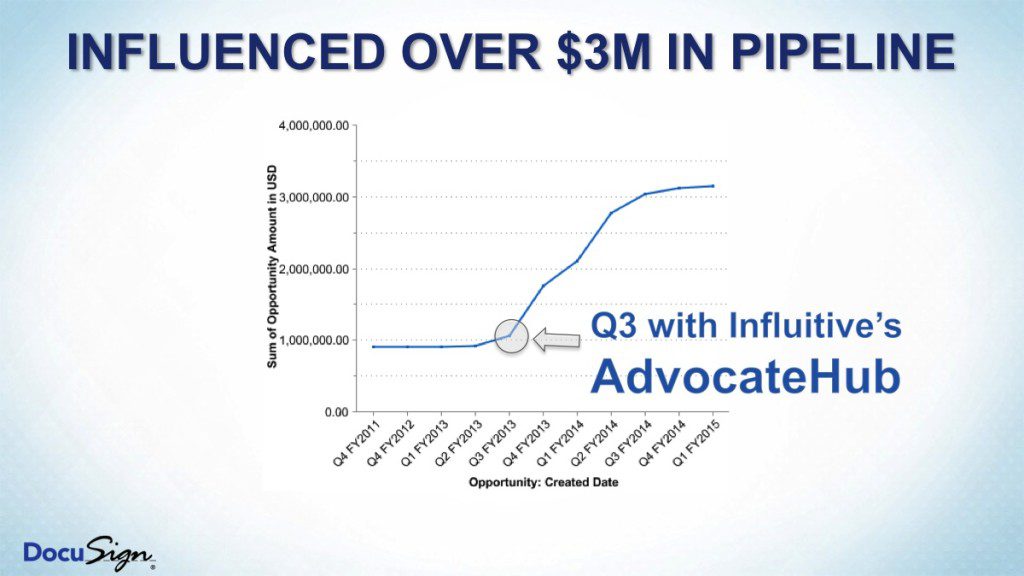DocuSign’s marketing team is laser-focused on a single mission: to acquire, keep and grow customers.
It seems like a pretty lofty goal for the marketing team of a digital transaction management company with millions of customers, doesn’t it? Thankfully, the marketers at DocuSign don’t have to go it alone.
In December 2012, DocuSign launched AdvocatesHQ, an advocate marketing program for customers and partners initially designed to increase social media engagement, generate more reviews and capture referrals.
 Today, DocuSign’s marketing team has more than 1,000 advocates helping them achieve their goals.
Today, DocuSign’s marketing team has more than 1,000 advocates helping them achieve their goals.
More importantly, the program has evolved from an engagement strategy into a revenue engine, influencing more than $3 million in pipeline – results that Ryan Schwartz, DocuSign’s Director of Marketing Systems and Operations, revealed at SiriusDecisions’ Summit last week.

This slide from Ryan Schwartz’s SiriusDecisions Summit presentation illustrates advocates’ impact on DocuSign’s sales pipeline, showing a sharp increase when the company’s demand gen team got involved.
From social buzz to revenue engine
Before AdvocatesHQ, DocuSign ran a small program called Signature Rewards to recognize and reward their biggest advocates.
It wasn’t until they added Influitive’s AdovcateHub software to their marketing technology stack that the company’s social team started to develop a more comprehensive advocacy program that would scale as their enormous customer base continued to grow.

Like many success stories, DocuSign’s advocate marketing program went through many iterations before really taking off.
Here’s how they did it:
Phase 1: Reviews, referrals and social
Objectives: Social engagement, reviews and referrals
Advocates: Sampling of corporate customers, Signature Rewards members, partners
They started small, inviting their partners, a sampling of their corporate customers and, of course, Signature Rewards members into the new program.
 DocuSign asked these early advocates to submit referrals, engage with the company on social media and post product reviews, contributing to more than 1,900 new Salesforce.com AppExchange reviews in just eight weeks.
DocuSign asked these early advocates to submit referrals, engage with the company on social media and post product reviews, contributing to more than 1,900 new Salesforce.com AppExchange reviews in just eight weeks.
Today, DocuSign has 4,300 AppExchange reviews and counting, and Ryan noted that the company has become the highest-rated eSignature application across all major review sites.
The social team drove strong early results with their advocate marketing program, but soon realized that they would have to adjust their approach to ensure long-term success.”Interest dropped off because we were just hammering customers with asks,” Ryan explained.
Phase 2: Dialogue-driven customer engagement
Objectives: Advocate activities, conversations and idea generation
Advocates: Phase 1 + all corporate/enterprise customers, employees, real estate customers
DocuSign’s social team wondered how they could keep engagement high to ensure their well of advocacy wouldn’t dry up.
 They started by changing the way they thought about advocate marketing and tweaked the asks they were publishing in AdvocatesHQ.
They started by changing the way they thought about advocate marketing and tweaked the asks they were publishing in AdvocatesHQ.
Instead of telling advocates what they should do, the team asked them what they would like to do.
DocuSign’s advocates responded in force, generating a ton of new ideas for how they could contribute to all areas of marketing.
Advocates also started to see more fun challenges geared toward engagement: “Without DocuSign my life would be… [fill in the blank]” (right) or “Where are some of the coolest places you have been while signing documents with DocuSign? Upload your pictures and share them with us!”
Phase 3: Turning AdvocatesHQ into a revenue engine
Objectives: Demand generation, creative programs and fun challenges
Advocates: Phases 1-2 + mobile users, EMEA customers and media
Once advocate engagement shot back up, Ryan said, they asked themselves yet another important question: “How do we move from ‘soft stuff’ to directly impacting revenue?”
 That’s when DocuSign’s demand generation team got involved. They split ownership of the advocate marketing program with the social team, and also brought in someone dedicated to driving advocacy at DocuSign.
That’s when DocuSign’s demand generation team got involved. They split ownership of the advocate marketing program with the social team, and also brought in someone dedicated to driving advocacy at DocuSign.
This new cross-functional team started tracking when, where and how advocates shared content related to their campaigns in Q3 2013. They had greater visibility into when prospects were interacting with that content, and then entering the marketing and sales funnel.
Together, they realized that the AdvocatesHQ advocate marketing program was a key way to drive results – especially for some of their more creative campaigns, such as National ESIGN Day and Perceptive or pompous: What does your signature say about you? (right).
Ultimately, they could track their advocates’ true influence over revenue in Salesforce.com and understand just how much value they were bringing to the company: more than $3 million in pipeline to date.
The big realization about advocate marketing
DocuSign’s results highlight that advocate marketing programs create more than just revenue: when done right, they can have a direct, significant impact on revenue.
“Advocate marketing is more than customer engagement: it’s customer acceleration,” Ryan concluded at the Summit.
Since the launch of AdvocatesHQ, DocuSign’s advocates have contributed:
- 64 testimonials
- 87 referrals
- 164 reviews
- 400+ social activities
- 2,000+ acts of advocacy
- $3 million+ in pipeline
5 lessons learned from DocuSign’s advocates
The moral of DocuSign’s advocate marketing story is that there’s always something you can change, tweak or improve to create better results.
 Ryan closed off the SiriusDecisions Summit session by sharing what DocuSign’s social and demand gen teams learned throughout the three phases of their advocate marketing journey so far:
Ryan closed off the SiriusDecisions Summit session by sharing what DocuSign’s social and demand gen teams learned throughout the three phases of their advocate marketing journey so far:
1. Advocate marketing is a customer acceleration tool
Advocate marketing is about more than just promoting social engagement, Ryan said. “It’s a customer acceleration tool that can have significant impact on pipeline and revenue.”
2. Use advocate marketing to grow your customers
Don’t just ask your customers to do favors for you. Advocate marketing is a channel through which your customers can grow, interact with you and feel appreciated for everything they do.
3. Commit to a mix of challenge types
When your advocates are asked to do the same types of activities over and over again, they’re more likely to get bored or burn out. Avoid this by committing to share a variety of relevant challenges with them, ranging from social engagement and content sharing, to referrals, reviews and references, to fun and educational.
4. Post new challenges each week
Nothing kills engagement faster than an advocate marketing program with no challenges. Posting a mix of new challenges each week ensures that advocates always have something new to interact with.
5. Seek and implement the advice of Influitive’s Advocacy Coaches
They are the true advocate marketing experts. No matter what your objectives or biggest challenges are, Advocacy Coaches are here to help. DocuSign worked closely with their Advocacy Coach, Sydney, to figure out which strategies and content would work best with their advocates every step of the way.












































